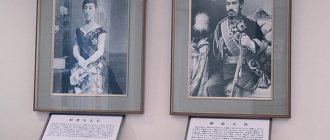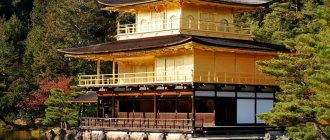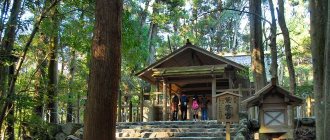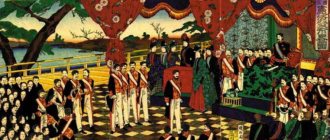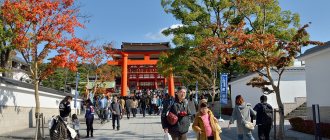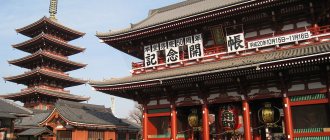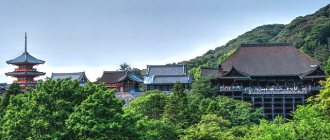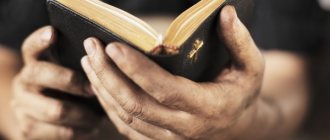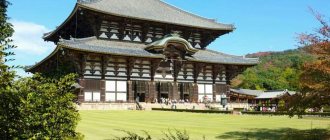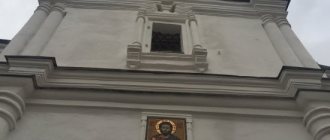Torii is one of the unspoken symbols of Japan. Two posts joined at the top by two crossbars, varnished in bright red or showing the natural beauty of bare wood. Most often, torii are installed in front of Shinto shrines, and sometimes you can see real corridors formed by torii along the entire path to the shrine. But they can often be seen standing alone in open areas or in water. Where do these gates lead without doors and walls? Into the sacred world of kami - deities and spirits of Shinto , the national religion of the Japanese.
Shinto shrines
People visit shrines to honor the kami or pray for good luck. Shrines are also visited during special events such as New Year, Setsubun, Shichi-Go-San and other festivals. Newborns are traditionally brought to the temple a few weeks after birth, and many couples hold their wedding ceremonies there.
Things to Remember When Visiting Temples in Japan
The following structures and objects can usually be found in the temple:
Torii
One or more torii gates mark the approach and entrance to the temple. They come in different colors and are made from different materials. Most torii, however, are made of wood and are colored orange and black.
Komainu
Komainu are a pair of guardian dogs or lions that can often be found on each side of a temple entrance. In the case of Inari shrines, they are foxes (see picture) rather than dogs.
Wash basin
Water in ponds, troughs, and fountains is used for cleaning. You must rinse your hands and mouth before entering the main hall (more details) hall
Main premises
Depending on the architectural style of the temple, the main hall (sopaki) and the offering hall (haiden) are two separate buildings or combined into one building. The central room of the main hall contains a sacred object, the shrine, and visitors make their prayers and offerings in the offering hall (more details).
No. Theater能 Japanese Drama Theater
Theater
In some shrines you can find stages for kagura dances or theatrical performances. Noh (能) is a form of theater involving music, dance and drama that originated in the 14th century. Shrines, temples and the nobility were among the first patrons of the NO theater. Accordingly, some famous shrines and temples still have beautiful outdoor NO scenes.
Ema
Visitors to the temple write their wishes on these wooden tablets and then leave them at the temple in the hope that their wishes will come true. Most people wish for good health, success in business, passing entrance exams, love or wealth.
Shinto shrines (shrines)
Shinto shrines are called jinja (abode of kami), although the endings -jingu or -gu can also be found in the names. These names and the torii gate are the surest differences between Shinto shrines and Buddhist ones. The shrine houses the kami, who prefer to live surrounded by nature, and is a place where they are served and worshiped. There are different styles of temple architecture, but traditional Shinto shrines are built from unpainted cypress wood and covered with thatch. Noteworthy are tigi - crossed protruding beams at the ends of the roof and katsuogi - short beams laid horizontally on the roof ridge. The best examples of such traditional architecture are the Ise Grand Shrine, Izumo Taisha (near Matsue) and Tokyo's Meiji Jingu. Later structures show Chinese or Korean influence by using red and white paint or other finishes.
Perhaps the most distinctive feature of the shrine is the torii gate , which symbolizes the entrance from the earthly world to the spiritual world. It is usually a simple wooden structure of two posts with two crossbars crossing them. There are 20 main types of torii, many of them colored red. Today they are also made of stone, metal, reinforced concrete; in these cases the gates are not painted. The word torii means "bird's perch" and until 1884 this was a common form of common gate; later they began to be installed only for sanctuaries.
Somewhere in the shrine there is often a sacred tree, indicated by a twisted rope (shimenawa) with strips of white paper around it. In the old days it was believed that this was the special home of some kami. Now trees only symbolize divine power, which, like other parts of the surrounding nature, helps human consciousness to renounce the mortal world and approach the world of kami.
On the territory of the sanctuary, closer to the building, you can often find sculptures of animals and people; stern dignitaries in ancient court costumes with weapons are traditional Japanese guards. True, you can also find dogs with lion heads (koma inu) or the fierce-looking Nio, clearly taken from a Buddhist temple. Other figurines may belong to messengers of the kami; foxes, for example, in the shrines of Inari, the god of rich harvests.
Finally you enter the sanctuary building itself . At the entrance there is a box for donations, at the top there is a rope with a bell or gong. Some say that the sound of the bell drives away evil spirits, others say that it attracts the attention of the kami. Another shimenawa designates the sacred habitat of the kami. Inside each shrine there are inner chambers (honden) where the shintai (shrine) is kept. It is a sacred object, indicating the presence of a kami, and is therefore always kept under lock and key; if he is seen, he will lose his miraculous power. In some sanctuaries, the role of such objects is played by mirrors. At the front of the honden is a donation table containing gohei, a symbolic donation of sticks wrapped in a zigzag pattern with white paper, and cleansing sacrificial sticks (haraigushi). Sometimes a mirror is placed here, between the table and the shrine. It fulfills an important mythological and religious mission, since it symbolizes not only the unclouded consciousness of the kami, but also the sincerity of believers, reflecting everything as it really is. In some cases, the mirror itself may be a sacred object; for example, the mirror given by the goddess Amaterasu to her grandson Ninigi is supposedly kept in the honden of the Ise Jingu Shrine, the main Shinto shrine in Japan.
Large shrines are usually a complex of buildings, including small shrines, a prayer hall (haiden), an ablution pavilion, an offering hall, an office, and a souvenir shop; housing for priests, a treasury and sometimes even a stage for ritual dances, Noh theater performances or a sumo arena. True, in some cases the shrines are just a torii and a twisted rope around a tree or stone to mark the sacred habitat of the Komi. It happens that an entire mountain is declared sacred, but this is already rare. Until the end of the last century, access to such mountains (and there are plenty of them in Japan) was prohibited for women. Nowadays, only two sacred mountains - Ushiro-yama in Okayama Prefecture and the top of the Sanjo-ga-Take ridge near Nara - are allowed to be climbed by women; both peaks are shrines of the Shugendo sect.
Omikuji
Omikuji are fortune-telling papers found in many shrines and temples. Randomly drawn, they contain predictions ranging from Daikichi (“great luck”) to daike (“great bad luck”). By tying a piece of paper to a tree branch, good luck will come true and bad luck can be prevented. They are usually obtained by making a small donation (usually a five yen coin, as it is considered good luck) and randomly choosing one from a box, hoping that the resulting luck will be good.
Shimenawa
Shimenawa is a straw rope with white zigzag paper strips (shide). It marks the boundary of something sacred and can be strung at torii gates, around sacred trees and stones, etc. During ritual ceremonies, yokozuna, the highest ranking sumo wrestlers, wear a rope similar to a shimenawa.
The last samurai Yukio Mishima and his genius trouble Japan 50 years after hara-kiri.
There may be various additional buildings, such as a priest's house, an office, a storage room for Mikoshi (portable sacred storage) and other supporting buildings. On the other hand, cemeteries are almost never found at shrines because death is considered a cause of impurity among Shintoists. Funerals in Japan are mainly carried out by Buddhists.
The architecture and features of Shinto shrines and Buddhist temples have merged over the centuries. There are several styles of construction, most of which show (Buddhist) influences from mainland Asia. Few of the modern shrines are considered to be built in a purely Japanese style. Among them are the most important Shinto shrines in the city of Ise.
There are tens of thousands of shrines in Japan, some of which can be divided into several main groups of shrines.
Some of these groups:
- Imperial Shrines These are shrines that were directly funded and administered by the government during the era of State Shintoism. These include many of the most important Shinto shrines, such as Ise Shrine, Izuma Shrine and Atsuta Shrine, as well as a number of shrines newly built during the Meiji period, such as Tokyo Meiji Shrine and Kyoto Heiana Shrine. Imperial shrines can be recognized by the chrysanthemums of the imperial house and by the fact that they are often called "jingu" rather than "jinja".
- Inari Shrines Inari Shrines are dedicated to Inari, made from rice. They can be recognized by their fox statues, since the fox is considered the messenger of Inari. There are thousands of Inari shrines in Japan, with the Kyoto Fushimi Inari Shrine being the most famous.
- Hachiman Shrines
- Hachiman shrines are dedicated to Hachiman, the kami of war who was especially popular among the leading military clans of the past. Of the thousands of Hachiman shrines in Japan, perhaps the most famous is Kamukura Tsurugaoka Hachimangu.
- Tenjin Shrines Tenjin Shrines are dedicated to the kami Sugawara Michizana, a scientist and politician of the Heian period. They are especially popular among students preparing for entrance exams. Tenjin shrines can be identified by bull statues and plum trees, Michizane's favorite trees. The first and most famous Tenjin temple is Dazaifu Tenmangu Temple near Fukuoka.
- Tenjin Shrines
- Sengen Shrines are dedicated to Princess Konohanasakuya, the Shinto deity of Mount Fuji. There are more than a thousand Sengen shrines throughout Japan, with the main shrines standing at the base and summit of Mount Fuji.
- Shrines dedicated to the founders of powerful clans Some powerful clans in Japanese history founded and dedicated shrines to the founders of their clans. The most famous example are the several dozen Toshogu shrines dedicated to Tokugawa Ieyasu, including the famous Toshogu Shrine in Nikko. Another example is the Kanazawa Oyama Shrine, dedicated to Maeda Toshiie, the founder of the powerful local Maeda clan.
- Local Shrines Many shrines are dedicated to local kami with no connection to other shrines.
Unsuccessful gay rule during the Edo period.
Views: 2,420
Share link:
- Tweet
- Share posts on Tumblr
- Telegram
- More
- by email
- Seal
Liked this:
Like
Christian churches in Japan
The main temples of Japan, as a rule, preach Buddhism or Shintoism. However, there are also Orthodox churches on the territory of the Land of the Rising Sun. They appeared thanks to Hieromonk Nicholas, who secretly baptized three Japanese who wished to join Orthodoxy. This happened in the second half of the 19th century. And already at the beginning of the 20th century, Orthodox communities numbering 266 appeared in Japan.
Nikorai-do Temple
The Japanese renamed the temple. In fact, its name sounds like the Church of St. Nicholas. The religious building is located at Ochanomizu Station. Due to the peculiarities of the religious movement, the temple building is significantly different from the buildings located in the area. The primate of the temple is the Archbishop of Tokyo Ikuo Nushiro. He is also called the Metropolitan of All Japan.
At the beginning of the 20th century, the temple building was restored, as it was significantly damaged after the earthquake. At the moment, Nikorai-do is the main representative of Orthodox churches in Japan.
Despite the fact that for the most part the temple is very similar to Orthodox buildings in Russia, upon closer examination of the details, it becomes clear that there are still differences. First of all, the difference is noticeable in the atmosphere reigning in the temple.
The decoration of the temple contains a lot of bright accents, demonstrating luxury and a certain pomp. Candles differ in size, and even the aroma emanates from them is completely different.
The service in the church does not miss a single stage, everything happens according to the established algorithm. However, sometimes you can meet Orthodox women who do not cover their heads or come in trousers.
Resurrection Temple in Hakodate
In 1858, the first Russian consulate was opened in Hakodate. Along with this, the first Japanese Orthodox church appeared. The architect of the temple was I. A. Goshkevich, who is the Russian consul. He hoped to resurrect Orthodoxy in Japan, which was once already accepted by society here. It was decided to dedicate the new temple to the Resurrection of Christ.
The Resurrection Temple was built on the highest point in Hakodate. It was made of wood. The building had two floors and a bell tower adjoined it. There was a dome with a cross on the roof.
The first Orthodox community was founded thanks to Nikolai Kasatkin, who began his service in the church in 1861. A language and catechetical school operated at the church. In 1872, the Japanese first heard the ringing of bells, which could not attract them. At first, the Orthodox Church was not accepted by society. They tried to expel people preaching Orthodoxy from the city; the printing house that carried out its work at the church was closed. But already in 1873, Orthodoxy in Japan was officially permitted.
The Church of the Resurrection has undergone restoration several times. At the moment, it is one of the main symbols of Orthodoxy in Japan. A Sunday school continues to operate at the church; adults can attend special courses. The songs of the choir still sound within the walls of the temple. Yielding to newfangled trends, the parish website began to grow and develop.
Church of the Transfiguration in Sapporo
The history of the appearance of the temple on the territory of the city of Sapporo began with the arrival of Mark Abe in 1884, who opened his shop. Mark was a Christian who previously lived in Otaru. First, a prayer house was organized where the Orthodox community gathered. A little later, in 1894, a separate building for Orthodox rites was built. The erected temple was dedicated to the Transfiguration of the Lord.
The temple experienced both difficult years and periods of prosperity. After the Russian Revolution, the temple ceased to be financed by Russia, completely switching to self-sufficiency. After this, the Orthodox community began to independently publish a newspaper. At the end of the 20th century, the location of the temple changed due to the start of the Olympic Games. The church was moved to another location. Unlike other Orthodox churches in Japan, the Transfiguration Church is crowned with not one, but six domes. Most of the icons located in the temple were painted by Irina Yamashita, a famous icon painter. It is believed that the temple in Sapporo houses a collection of her works.
The architecture of temples is extremely diverse, despite the fact that there are fundamentals that the Japanese try to adhere to. In most cases, the sacred structure has a rectangular shape, framed by a roof with a roof. Modern churches are made of fire-resistant materials for safety purposes. The main building material can be reinforced concrete or brick. And the roof, most often, is made of various metals. Each temple located in Japan has a unique history and deserves attention. Having visited the walls of this or that temple, you have the opportunity to touch the unusual Japanese culture and get acquainted with a hitherto unfamiliar world. Japanese temples were built in harmony with the surrounding nature; every detail of the structure carries a certain meaning, which arouses genuine interest among tourists.
